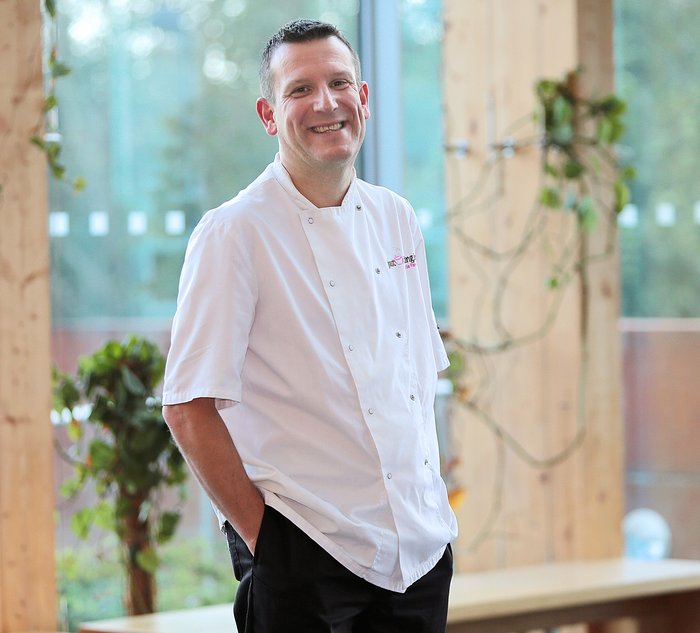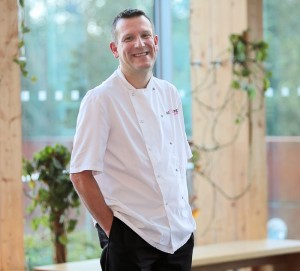
 Mark Doe of Just Cooking Cookery School in Firies gives his tips on great barbecuing…
Mark Doe of Just Cooking Cookery School in Firies gives his tips on great barbecuing…
In Ireland we only barbecue on average around two times a year, and when we do the most popular item cooked is black sausages!
During my training we cooked amazing foods on the BBQ including beer can chicken, garlic flat breads, pizza, mushroom risotto, pulled chicken burgers with bacon jam, chocolate cake with grilled orange mascarpone, stuffed mushrooms and even sticky toffee pudding.
I barbecue all year round and tend to use my barbecue more than my oven when it comes to cooking at home.
Gas Vs Charcoal is a question I often get asked, and really they both have their advantages and disadvantages.
Continued below…

When buying a BBQ, buy the best you can afford, as if looked after they have a longer life span.
Cleaning your BBQ isn’t as hard as you think. The best way to clean the grill is to burn the debris off.
So get the BBQ grill hot before cooking and then brush with a wire brush. Clean the rest of the BBQ with warm soapy water.
We run two types of BBQ cookery classes at Just Cooking, our evening demo class and our hands on classes. For more information see our website www.justcooking.ie
Cooking methods
Direct Method
Food is cooked directly over the heat source. For even cooking, food should be turned once halfway through the grilling time.
Use the direct method for foods that take less than 25 minutes to cook: like steaks, chops, kabobs, sausages and vegetables.
Direct cooking is also necessary to sear meats. Searing creates that wonderful crisp, caramelized texture where the food hits the grate. \
It also adds nice grill marks and flavor to the entire food surface. Steaks, chops, chicken pieces, and larger cuts of meat all benefit from searing.
To grill by the Direct Method on a charcoal grill, spread prepared coals evenly across the charcoal grate.
Set the cooking grate over the coals and place food on the cooking grate. Place the lid on the grill and lift it only to turn food or to test for doneness at the end of the recommended cooking time.
To grill by the Direct Method on a gas grill, preheat the grill with all burners on High. Place the food on the cooking grate, then adjust all burners to the temperature noted in the recipe.
Close the lid of the grill and lift it only to turn food or to test for doneness at the end of the recommended cooking time.
Indirect Method
The Indirect Method is similar to roasting, but with the added benefits of that grilled texture, flavor, and appearance you can’t get from an oven.
Heat rises, reflects off the lid and inside surfaces of the grill, and slowly cooks the food evenly on all sides.
The circulating heat works much like a convection oven, so there’s no need to turn the food.
Use the Indirect Method for foods that require 25 minutes or more of grilling time or for foods that are so delicate that direct exposure to the heat source would dry them out or scorch them.
Examples include roasts, ribs, whole chickens, turkeys, and other large cuts of meat, as well as delicate fish fillets.
To grill by the Indirect Method on a charcoal grill, arrange hot coals evenly on either side of the charcoal grate.
A drip pan placed in the center of the charcoal grate between the coals is useful to collect drippings that can be used for gravies and sauces. It also helps prevent flare-ups when cooking fattier foods such as goose, duck, or fatty roasts.
For longer cooking times, add water to the drip pan to keep drippings from burning. Place the cooking grate over the coals and place the food on the cooking grate, centered over the drip pan or empty space.
Place the lid on the grill and lift it only to baste or check for doneness at the end of the suggested cooking time.
To grill by the Indirect Method on a gas grill, preheat the grill with all burners on High. Then adjust the burners on each side of the food to the temperature noted in the recipe and turn off the burner(s) directly below the food.
For best results, place roasts, poultry, or large cuts of meat on a roasting rack set inside a disposable heavy-gauge foil pan. For longer cooking times, add water to the foil pan to keep drippings from burning.
Cooking with charcoal
Do not be tempted to fill the Barbecue full of charcoal in the hope of making a bigger, longer lasting fire. It is simply a waste of charcoal and it will become too hot to cook on.
• Remove the lid if there is one and open all vents on the barbecue.
• Spread the charcoal briquettes 2 layers deep over the base of the barbecue.
• Scoop it back into a pyramid and tuck in the fire lighters.
• Light the fire lighters and leave for 20-25 minutes until the coals start to glow red.
Cleaning your BBQ
The best time to clean your BBQ is when it is hot. I know the last thing you want to do after eating (and a few glasses of wine!!!) is clean up, but it is easier whilst the BBQ is hot.
I use a wire brush to clean of any stuck debris on the grill.
If you have a gas BBQ light it for a few minutes for the grill to dry through.
Gas Vs Charcoal
Gas is easier to use as it can be lit quickly.
Charcoal is said to give the food better flavor.
The key to using gas and getting that charcoal flavor, is to cook the food with the lid down. This captures the smoke and gives you a great flavor.
Buying a Barbecue
When buying a barbecue you really do get what you pay for.
Cheap gas barbecues are never really hot enough to cook plenty of food on as they may only have one burner.
Also cheaper barbecues tend to rust quickly.
Keep the barbecue in a shed during the Winter months. During the Summer when it is outside keep it covered.
Recipes
BBQ pork chops with prosciutto and sage
Serves 4
Ingredients
4 Boneless pork loin chops
Sea salt
Freshly ground black pepper
4 paper-thin slices prosciutto (Parma ham)
Extra-virgin olive oil
Sauce
3 tablespoons unsalted butter
1 tablespoon finely chopped fresh sage leaves
1 tablespoon fresh lemon juice
Method
Using a sharp knife, butterfly each pork chop by making a slit halfway up the one side of the escalope and enlarging the slit to extend to within ½ inch of the opposite side.
Do not cut all the way through. Open each escalope like a book. Season the inside with salt and pepper.
Lay one slice of prosciutto inside escalope, folding the prosciutto to fit, if necessary. Close the escalope and press tightly. Lightly brush the outside of the each one with oil and season evenly with salt and pepper.
Brush the cooking grates clean. Grill the pork chops over a medium heat with the lid closed, until nicely browned on the outside with just and then turn.
Cook until a core temperature of above 75c is reached and the juices of the pork run clear. This will take approx. 8 minutes in total minutes Meanwhile, make the sauce.
In a small saucepan over medium heat, melt the butter and cook until bubbly, 2 to 3 minutes. Add the sage and cook for about 1 minute.
Remove the saucepan from the heat. Allow the butter to cool for about 1 minute. Add the lemon juice to the melted butter, and then immediately spoon the sauce over chicken Serve right away.
Citrus marinated chicken fillet with grilled onions
Serves 6-8
Ingredients
1 tablespoon finely grated lemon zest (from about 2 lemons)
50ml fresh lemon juice
50ml fresh orange juice
2 tablespoons soy sauce
2 tablespoons finely chopped fresh coriander leaves
1 tablespoon grated, peeled fresh ginger
Extra-virgin olive oil
4 boneless, skinless chicken breast halves, each about 6 ounces
1 red onion, about 12 ounces, cut crosswise into ½-inch-thick slices
1 teaspoon kosher salt
½ teaspoon freshly ground black pepper
Method
In a large, resalable plastic bag combine the marinade ingredients, including 2 tablespoons oil. Place the chicken in the bag, press the air out of the bag, and seal tightly.
Turn the bag to distribute the marinade, place the bag in a bowl, and refrigerate for 3 to 5 hours, turning occasionally.
Brush the onion slices with oil. Remove the chicken from the bag and discard the marinade.
Season the chicken evenly with the salt and pepper, and then grill over medium heat with the lid closed, until the meat is firm to the touch and no longer pink in the centre, 8 to 12 minutes, turning once.
At the same time, grill the onions until tender, 12 to 15 minutes, turning once or twice. Remove from the grill as they are done, and let the chicken rest for 3 to 5 minutes.
Cut the chicken crosswise into ½-inch-thick slices. Serve warm with the onions
Baby potato salad
Serves 4
750 g of new baby potatoes, washed 6 bacon rashers, cut into strips
1 red onion, peeled and finely diced 1 tablespoon of red wine vinegar
4 tablespoons of extra virgin olive oil 1 bunch of scallions
2 teaspoons of wholegrain mustard 1 tablespoon of chopped parsley
Salt and freshly ground pepper
Method
Boil or steam the potatoes until tender.
Drain and allow to cool.
Fry the bacon in a frying pan until crisp, then add the red onion and cook until softened.
Remove from the heat and add the red wine vinegar, mustard, scallions and olive oil
Toss through the potatoes and season with salt and pepper.
Finish with chopped parsley.
Fish Tacos-Serves 6
350g cod fillet skinned and cut into cubes
350g salmon fillet cut into cubes
6 corn tortillas
For the salsa
4 on the vine tomatoes
4 spring onions finely chopped
1 garlic clove finely chopped
1 lime juice
1 tbsp extra virgin olive oil
Sea salt and freshly ground black pepper
For the dry rub
1 tsp paprika
1 tsp dried oregano
1tsp soft light brown sugar
1 tsp ground cumin
Pinch of salt
For the garnish
100ml sour cream
1 avocado
10g coriander
1 lime cut into small wedges
Method
Make the salsa by mixing all of the ingredients together.
Next make the dry rub by combining all of the ingredients in a small bowl.
Toss the fish in a little oil and then dust the fish with the rub.
Prepare the barbecue for direct heat approx 200c. Preheat a cast iron griddle pan on the grill.
Brush the plate with a little oil. Sear the fish for 3-4 minutes on each side.
Place on a warm plate and sprinkle with the coriander.
Very quickly grill the tortillas for a few seconds on each side.
To assemble fill each tortilla with a few chinks of fish, sour cream, avocado and salsa.
Fold and serve.
Cous cous salad-serves 10
200g of Couscous
400ml Boiling vegetable or chicken stock.
8 cherry tomatoes, left whole
1 courgette, cut into ½ inch chunks
1 red pepper, de-seeded and cut into a ½ inch dice
1 yellow pepper, de-seeded and cut info a ½ inch dice
1 large carrot, cut into a ½ inch dice
4 tbsp olive oil
Juice of 1 lemon
150g Feta cheese, crumbled
4 tbsp finely chopped flat parsley
5 tbsp extra virgin olive oil
salt and pepper to season
Method
Preheat oven to 180˚C.
Place the prepared vegetables and tomatoes in a very large roasting dish and spread out to a single layer. Drizzle with the oil and season with sea salt and pepper to taste. Roast for about 45 minutes or until the vegetables are tender.
Place the Couscous in a large bowl and cover with boiling stock.
Cover tightly with clingfilm and leave to stand for 9 minutes.
Remove the clingfilm from the Couscous, add the extra virgin olive oil, lemon juice, parsley and feta.
Fluff up with a fork and stir through the feta and roast vegetables.
Season to taste and serve.



 Mark Doe of ‘Just Cooking’ Cookery School in Firies has recipes and tips to serving up an amazing Christmas dinner…
Mark Doe of ‘Just Cooking’ Cookery School in Firies has recipes and tips to serving up an amazing Christmas dinner…















































